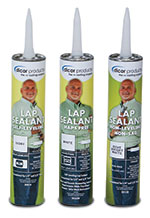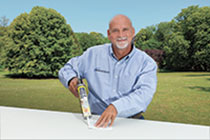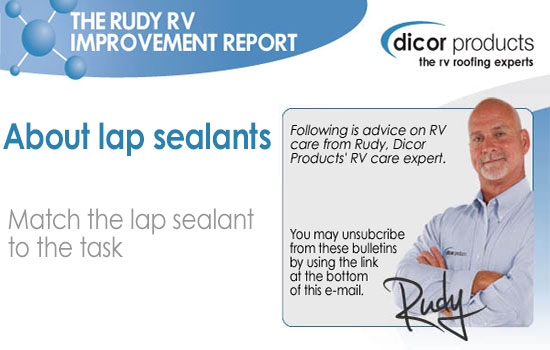One of the easier do-it-yourself jobs you can perform with your RV is the application of lap sealant, either to make repairs (click here for article or here for video) or with the installation of a new roof appliance.

As with any repair or installation, it is important to choose the right material for the job. In the case of your RV roof, that means not walking into a hardware store and picking up the usual tube of window caulk you're familiar with, but going to an RV dealer or RV supply store to obtain a sealant specifically formulated for RV roofs. Why? So it will stick!
Most RV roofs today are made of EPDM or TPO material. The silicone sealants found in a typical home repair place will form a nice hard seal, but once it fully cures it will come loose before too long.
Lap sealants formulated for RV roofs, on the other hand, are made to bite into the EPDM or TPO roof material (Dicor lap sealant also works with metal and fiberglass) and hold fast. In the case of a common EPDM roof, lap sealants like Dicor's self-leveling and non-sag, non self-leveling sealants contain an oil-based solvent that reacts with the oil-based elements in the roofing material. At first, this reaction will actually cause the roofing material to swell a bit — you might even get a slight rippling effect. But don't worry! This is only temporary while the reacting oils evaporate, which brings the roof back to its normal state and, most importantly, essentially fusing the sealant and roofing material together.
 The other thing you need to know about RV sealants is the distinction we noted above: self-leveling vs. non-sag, self-leveling sealants. Most simply, self-leveling is used for horizontal surfaces and non-sag, non self-leveling is used for vertical applications.
The other thing you need to know about RV sealants is the distinction we noted above: self-leveling vs. non-sag, self-leveling sealants. Most simply, self-leveling is used for horizontal surfaces and non-sag, non self-leveling is used for vertical applications.
Self-leveling sealant spreads out after it comes out of the container; that is, it may come out looking like a Hershey Kiss®, but it will soon flow and flatten turning into a wafer-like shape. It is made to cover horizontal seams and cracks and the base flange edges of appliances that are only a quarter-inch or less offset from the roof.
For a flange that extends more than a quarter-inch off the roof, non-sag, non self-leveling sealant is recommended to securely seal the flange with the roof. This is because non-sag, non self-leveling sealant does not change shape after it is dispensed from the tube and it is easy to layer and build up around an appliance base for a solid seal. In other words, if it comes out like a Hershey Kiss it stays like a Hershey Kiss. Conversely, if you were to use a self-leveling sealant around a flange edge that stuck up more than a quarter inch, it would spread out and only leave a thin covering on the flange edge. Attempting to apply additional coats to build it up would simply waste additional sealant.
One mistake people sometimes make with lap sealant is to put too much on in an attempt, no doubt, "to really fill the gap." Too much, however, tends to make the sealant "skin over," trapping solvents that need to evaporate and lengthening the curing time. This can result in "surface cracks" in the skin. This is not a functional concern — these are simply surface cracks and do not compromise the seal, which will remain solid. But the cracks are not cosmetically appealing and the sealant is used up more quickly than necessary.
For its lap sealant, Dicor recommends a quarter- to three-eighth-inch-wide bead. No secondary work is necessary once you put it on. You don't have to trowel it or spread it. You simply put it on and it will do the job — provided you've made the proper preparation (see links in first paragraph and here). Just make sure you have the kind of RV sealant that's right for the job.
More resources about RV care may be found through Rudy’s Resources for RV Owners at http://www.dicorproducts.com.


